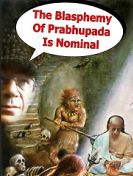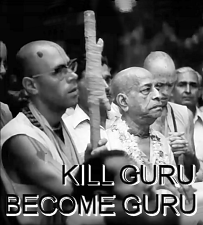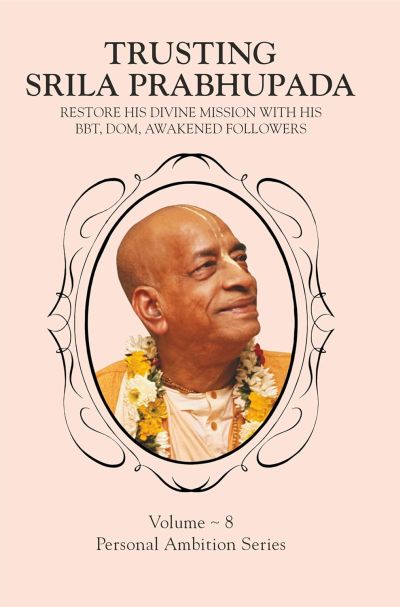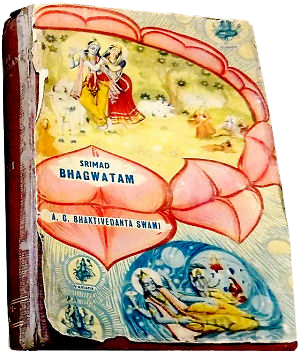 Israeli Jews bless the sun in rare 28-year prayer
Israeli Jews bless the sun in rare 28-year prayer
Birkat Hakhama is said as the sun comes up to mark what according to Jewish tradition is the sun’s return to its position at the moment that the universe was created 5,769 years ago. It returns to the spot once every 28 years.
As the faithful swayed back and forth in prayer, the area filled with the din of the Birkat Hakhama prayer.
Elsewhere around Israel and the occupied West Bank, tens of thousands of observant Jews sought out hilltops and rooftops to catch the first rays of the sun to recite the prayer.
Birkat Hakhama is said as the sun comes up to mark what according to Jewish tradition is the sun’s return to its position at the moment that the universe was created 5,769 years ago. It returns to the spot once every 28 years. go to story
PRABHUPADA: The modern historians of this earth cannot supply historical evidences of events that occurred before 5,000 years ago, and the anthropologists say that 40,000 years ago Homo sapiens had not appeared on this planet because evolution had not reached that point. But the Vedic histories, such as the Puranas and Mahabharata, relate human histories which extend millions and billions of years into the past.
Vedic histories go back millions, billions of years
from preface, KRSNA: The Supreme Personality of Godhead
There are various classes of men in the world who speak of God in different ways, but according to the Vedic literature and according to the great acharyas, the authorized persons versed in the knowledge of God in all ages, like acharyas Shankara, Ramanuja, Madhva, Vishnu Svami, Lord Chaitanya and all their followers by disciplic succession, all unanimously agree that Krishna is the Supreme Personality of Godhead. As far as we, the followers of Vedic civilization, are concerned, we accept the Vedic history of the whole universe, which consists of different planetary systems, called Svargaloka, or the higher planetary system, Martyaloka, or the intermediary planetary system, and Patalaloka, or the lower planetary system. The modern historians of this earth cannot supply historical evidences of events that occurred before 5,000 years ago, and the anthropologists say that 40,000 years ago Homo sapiens had not appeared on this planet because evolution had not reached that point. But the Vedic histories, such as the Puranas and Mahabharata, relate human histories which extend millions and billions of years into the past.
For example, from these literatures we are given the histories of Krishna’s appearances and disappearances millions and billions of years ago. In the Fourth Chapter of the Bhagavad-gita, Krishna tells Arjuna that both He and Arjuna had had many births before and that He (Krishna) could remember all of them but Arjuna could not. This illustrates the difference between the knowledge of Krishna and that of Arjuna. Arjuna might have been a very great warrior, a well-cultured member of the Kuru dynasty, but after all, he was an ordinary human being, whereas Krishna, the Supreme Personality of Godhead, is the possessor of unlimited knowledge. Because He possesses unlimited knowledge, Krishna has a memory that is boundless.
The knowledge Krishna possesses is so perfect that He remembers all the incidents of His appearances some millions and billions of years in the past, but Arjuna’s memory and knowledge are limited by time and space, for he is an ordinary human being. In the Fourth Chapter Krishna states that He can remember instructing the lessons of the Bhagavad-gita some millions of years ago to the sun-god, Vivasvan.
Millions of universes, each having the duration of Brahma’s life span
excerpt from lecture on Srimad-Bhagavatam 3.26.42, Bombay, Jan 17, 1975
The real God. Real God,
ishvarah paramah krishnah
sach-chid-ananda-vigrahah
anadir adir govindah
sarva-karana-karanam“Krishna who is known as Govinda is the Supreme Godhead. He has an eternal blissful spiritual body. He is the origin of all. He has no other origin and He is the prime cause of all causes.” [Brahma-samhita 5.1]
Sarva-karana-karanam, He never exhausts. He is never exhausted. It is said that,
yasyaika-nishvasita-kalam athavalambya
jivanti loma-vilaja jagad-anda-nathah
vishnur mahan sa iha yasya kala-vishesho
govindam adi-purusham tam aham bhajami“Brahma and other lords of the mundane worlds, appearing from the pores of hair of Maha-Vishnu, remain alive as long as the duration of one exhalation of the latter [Maha-Vishnu].” [Bs. 5.48]
The millions of universes are coming out within His breathing period, and again they are annihilated when the breathing is taken inside. In this way the universes are coming out. Jagad-anda-nathah. Jagad-anda-nathah. Jagad-anda means the universe, and natha, the Lord of the universe, means Lord Brahma. So he has got a duration of life. And what is that duration of life? The breathing period of Maha-Vishnu.
yasyaika-nishvasita-kalam athavalambya
jivanti loma-vilaja jagad-anda-nathah
vishnur mahan sa iha yasya kala-vishesho
govindam adi-purusham tam aham bhajami [Bs. 5.48]
That is God, that by breathing, unlimited number of universes are coming out and going in. And the duration of existence of each and every universe is the duration of life of Brahma. That we cannot calculate. Even we cannot calculate his twelve hours.
311,040,000,000,000 years
excerpt from Renunciation Through Wisdom, Chapter 2
Empirical, atheistic philosophers like Kapila spent innumerable tedious hours researching the material phenomena of this cosmic creation. Yet it remained beyond the grasp of their limited intelligence to understand that there exists a realm transcendental and far superior to this manifested material world. Finally, when their probing minds failed to sight land in an ocean of speculation, they concluded that the absolute truth is unmanifest.
Compared to other species, human beings are certainly endowed with good intelligence, yet unless they are devotees of the Lord, all their thinking is limited within mundane boundaries. Therefore it is impossible for the mundane mind to approach the transcendence. But instead of surrendering to the Supreme Lord or His representative, the empirical philosophers try to explain away as “unmanifest” that which is beyond their mundane minds. This is known as the logic of the frog in the well.
No matter how big a thinker a tiny living entity may be, all his activities are limited by mundane boundaries, just as a frog in the well can never comprehend that such a thing as an ocean exists outside his little domain. He refuses to acknowledge that a mass of water infinitely bigger than his tiny puddle can at all be possible. Similarly, we are trapped in the dark well of our body and mind. And although we may try hard through yoga or empirical speculation to overcome our limitations, no matter how erudite we are it is impossible to reach beyond the limitations of our self-made well.
So, who can bring us news of the great ocean? Is there any record of how long we have been struggling in the water to stay afloat in the well of this material world, sometimes going up to the higher planets, sometimes coming down? Only the Supreme Lord Himself or His empowered representative can possibly free us from confinement in this dark well. Under their guidance we can come to know of the limitless ocean of the spiritual sky. This process—hearing from higher authorities—is called the deductive, or descending, process of knowledge. It is the only authorized way to learn transcendental knowledge. By this method alone is eternal truth transmitted.
And what can we learn by this process? Lord Krishna describes the spiritual and material worlds as follows in the Bhagavad-gita (8.17-20):
“By human calculation, a thousand ages taken together form the duration of Brahma’s one day. And such also is the duration of his night. At the beginning of Brahma’s day, all living entities become manifest from the unmanifest state, and thereafter, when the night falls, they are merged into the unmanifest again. Again and again, when Brahma’s day arrives, all living entities come into being, and with the arrival of Brahma’s night they are helplessly annihilated. Yet there is another unmanifest nature, which is eternal and is transcendental to this manifested and unmanifested matter. It is supreme and is never annihilated. When all in this world is annihilated, that part remains as it is.”
People become awestruck when they learn that the life span on Brahmaloka is many millions of years. One has to undergo severe austerities and renunciation, accepting the sannyasa order of life, in order to reach Brahmaloka. However, we must consider one essential fact: even Lord Brahma, the presiding deity of that planet, is not immortal. Those who have researched the Vedic scriptures in depth can calculate the lifetime of Brahma. Human beings count 365 days in their year, and the cycle of four yugas comprises approximately 4,320,000 such years. A thousand cycles of four yugas make up one day-time (twelve hours) of Lord Brahma’s life. In this way his month and year can be calculated, and Brahma lives for a hundred years of his time. But despite this vast life span—311 trillion 40 billion human years—Lord Brahma is a mortal being, and this universe created by him is also perishable. Thus it is not strange that human beings, who are also his creation, should perish. As human beings seem immortal to a tiny insect, so Lord Brahma and the demigods seem immortal to us. In fact, however, no material body of any form is ever eternal.
At the end of Lord Brahma’s day, when night approaches, a partial dissolution inundates the universe up to the Svargaloka, the abode of the demigods. All the living entities of this world are created at the dawn of Lord Brahma’s day and annihilated at dusk, and this creation and annihilation go on in a continuous cycle.
Evidence of earlier civilizations
excerpt from Journey of Self Discovery, “Evolution in Fact and Fantasy”
DEVOTEE: Let’s just confine ourselves to this planet.
PRABHUPADA: No, why should we? Nature is not only on this planet.
DEVOTEE: Because you said that on this planet there were complex forms of living beings millions and millions of years ago.
PRABHUPADA: We are not talking about this planet, but about anywhere. You are referring to nature. Nature is not limited or confined to this planet. You cannot say that. Nature, material nature, includes millions of universes, and in each and every universe there are millions of planets. If you have studied only this planet, your knowledge is insufficient.
DEVOTEE: But you said before that millions of years ago on this planet there were horses, elephants, civilized men—
PRABHUPADA: Yes, yes.
DEVOTEE: But from hundreds of different sources there is no evidence.
PRABHUPADA: I say they are existing now—men, horses, snakes, insects, trees. So why not millions of years ago?
DEVOTEE: Because there is no evidence.
PRABHUPADA: That doesn’t mean… ! You limit your study to one planet. That is not full knowledge.
DEVOTEE: I just want to find out for the time being about—
PRABHUPADA: Why the time being? If you are not perfect in your knowledge, then why should I accept your theory? That is my point.
DEVOTEE: Well, if you claim that millions of years ago there were complex forms of life on this planet—
PRABHUPADA: Whether on this planet or on another planet, that is not the point. The point is that all species exist and keep on existing by the arrangement of nature. We learn from the Vedic texts that there are 8,400,000 species established. They may be in your neighborhood or they may be in my neighborhood—the number and types are fixed. But if you simply study your neighborhood, it is not perfect knowledge. Evolution we admit. But your evolutionary theory is not perfect. Our theory of evolution is perfect. From the Vedas we know that there are 8,400,000 forms of bodies provided by nature, but the soul is the same in all, in spite of the different types of body. There is no change in the soul, and therefore the Bhagavad-gita [5.18] says that one who is wise, a pandit, does not see the species or the class; he sees oneness, equality. Panditah sama-darshinah [Bg. 5.18]. One who sees to the bottom sees the soul, and he does not find there any difference between all these species.
DEVOTEE: So Darwin and other material scientists who have no information about the soul—
PRABHUPADA: They’re missing the whole point.
DEVOTEE: They say that all living things tend to evolve from lower to higher. In the history of the earth—
PRABHUPADA: That may be accepted. For example, in an apartment building there are different kinds of apartments: first-class apartments, second-class apartments, third-class apartments. According to your desire and qualification, as you are fit to pay the rent, you are allowed to move up to the better apartments. But the different apartments are already there. They are not evolving. The residents are evolving by moving to new apartments as they desire.
DEVOTEE: As they desire.
PRABHUPADA: Yes. According to our mentality at the time of death, we get another “apartment,” another body. But the “apartment” is already there, not that I’m creating the “apartment.”
And the classes of “apartments” are fixed at 8,400,000. Just like the hotel-keeper: he has experience of his customers coming and wanting different kinds of facilities. So he has made all sorts of accommodations to oblige all kinds of customers. Similarly, this is God’s creation. He knows how far a living entity can think, so He has made all these different species accordingly. When God thinks, “Come on, come here,” nature obliges. Prakriteh kriyamanani gunaih karmani [Bhagavad-gita 3.27]: Nature is offering facility. God, Krishna, is sitting in the heart of the living entity as Paramatma, and He knows, “He wants this.” So the Lord orders nature, “Give him this apartment,” and nature obliges: “Yes, come on; here is your apartment.” This is the real explanation.
DEVOTEE: I understand and accept that. But I’m still puzzled as to why there is no geological evidence that in former times on this planet there were more complex forms.
PRABHUPADA: Why are you taking geological evidence as final? Is it final? Science is progressing. You cannot say it is final.
DEVOTEE: But I have excavated all parts of the world, and every time—
PRABHUPADA: No. You have not excavated all parts of the world.
DEVOTEE: Well, on seven continents.
PRABHUPADA: Seven continents is not the whole world. You say you have excavated the whole world, but we say no, not even an insignificant portion. So your knowledge is limited. Dr. Frog has examined his three-foot-wide well, and now he claims to know the ocean.
Experimental knowledge is always imperfect, because one experiments with imperfect senses. Therefore, scientific knowledge must be imperfect. Our source of knowledge is different. We do not depend on experimental knowledge. Now you see no dinosaurs, nor have I seen all the 8,400,000 different forms of life. But my source of knowledge is different. You are an experimenter with imperfect senses. I have taken knowledge from the perfect person, who has seen everything, who knows everything. Therefore, my knowledge is perfect. Say, for example, that I receive knowledge from my mother: “Here is your father.” But you are trying to search out your father on your own. You don’t go to your mother and ask; you just search and search. Therefore, no matter how much you search, your knowledge will always remain imperfect.
DEVOTEE: And your knowledge says that millions of years ago there were higher forms of life on this planet.
PRABHUPADA: Oh, yes, because our Vedic information is that the first created being is the most intelligent, the most intellectual person within the universe—Lord Brahma, the cosmic engineer. So how can we accept your theory that intellect develops by evolution? We have received our Vedic knowledge from Brahma, who is so perfect.
Dr. Frog has studied his three-foot well, his little reservoir of water. The Atlantic Ocean is also a reservoir of water, but there is a vast difference. Dr. Frog cannot inform us about the Atlantic Ocean. But we take knowledge from the one who has made the Atlantic Ocean. So our knowledge is perfect.
DEVOTEE: But wouldn’t there be evidence in the earth, some remains?

Lord Brahma born from the navel of Maha Vishnu.
PRABHUPADA: Our evidence is intelligence, not stones and bones. Our evidence is intelligence. We get Vedic information by disciplic succession from the most intelligent. It is coming down by shruti, hearing. Vyasadeva heard from Narada, Narada heard from Brahma—millions and millions of years ago. Millions and millions of our years pass, and it is not even one day for Brahma. So millions and billions and trillions of years are not very astonishing to us, for that is not even one day of Brahma. But Brahma was born of Krishna, and intelligent philosophy has been existing in our universe from the date of Brahma’s birth. Brahma was first educated by God, and His knowledge has been passed down to us in the Vedic literature. So we get such intelligent information in the Vedas.
But those so-called scientists and philosophers who do not follow this system of descending knowledge, who do not accept knowledge thus received from higher authorities—they can’t have any perfect knowledge, no matter what research work they carry out with their blunt senses. So whatever they say, we take it as imperfect.
Higher and lower planetary systems and beyond…
excerpt from lecture given at Christian monastery on Srimad-Bhagavatam 1.2.5, Melbourne, Apr 3, 1972
So you have got a particular type of body. You have been given the chance of particular standard of living. Similarly, in India or in Africa or in other country, the living entity has got a particular type of body and his particular type of standard of living is also there. A tiger has got a particular type of body, it has got his own standard of living. Elephant has got a particular type of body, and it has got its standard of living. Similarly, there are higher beings also, in the higher planetary system. They are called Svargaloka, Janaloka, Maharloka, Tapoloka, Brahmaloka. In the Brahmaloka the duration of life is so long that you cannot imagine even calculating twelve hours’ time there. That is stated in the Bhagavad-gita. Most of you have read Bhagavad-gita, and it is stated there, sahasra-yuga-paryantam ahar yad brahmano viduh [Bg. 8.17]. Sahasra-yuga-paryantam. One yuga… This is Kali-yuga. At the present moment it is called Kali-yuga. Before this… This Kali-yuga has passed only five thousand years, and the duration of life of this Kali-yuga is 432,000’s of years. Only we have passed five thousand. Before this Kali-yuga there was another yuga, which is known as Dvapara-yuga. Before that, there was Treta-yuga. Before that, there was Satya-yuga. All these yugas, taking aggregate years, forty-three hundred thousands of years. And multiply it by one thousand. Then calculate what is the duration of time. That is only twelve hours duration in the Brahmaloka. Sahasra-yuga-paryantam ahar yad brahmano viduh [Bg. 8.17].
So there are very particular informations of all the planets within this universe. Not only within this universe; there are many other planets beyond this universe. That is called Vaikunthaloka, spiritual world. The spiritual sky is there. That is stated in the Bhagavad-gita. Paras tasmat tu bhavo ‘nyo ‘vyakto ‘vyaktat sanatanah [Bg. 8.20]. That is perpetual, that anything in that sky is perpetual, and anything within this material sky, they are temporary. In the Brahmaloka there may be duration of life millions of millions of year, but that is also destructible. That is material nature. In the Bhagavad-gita it is said, abrahma-bhuvanal lokah punar avartino ‘rjuna: [Bg. 8.16] “Even if you go to the Brahmaloka, you will have to come back again.” Yad gatva na nivartante tad dhama paramam mama [Bg. 15.6]. “But if you come to My loka…” There is Krishnaloka. That is in the spiritual world, spiritual sky.
Entire material cosmic manifestation only one-fourth of the energy of the Lord
excerpt from purport, Sri Ishopanishad, Mantra 14

Above and beyond the material cosmic manifestion is the abode of the Supreme Personality of Godhead, Goloka Vrindaban.
Lord Vishnu, the Personality of Godhead, possesses different energies, known as para (superior) and apara (inferior). The living entities belong to the superior energy. The material energy, in which we are presently entangled, is the inferior energy. The material creation is made possible by this energy, which covers the living entities with ignorance (avidya) and induces them to perform fruitive activities. Yet there is another part of the Lord’s superior energy that is different from both this material, inferior energy and the living entities. That superior energy constitutes the eternal, deathless abode of the Lord. This is confirmed in the Bhagavad-gita (8.20):
paras tasmat tu bhavo ‘nyo
‘vyakto ‘vyaktat sanatanah
yah sa sarveshu bhuteshu
nashyatsu na vinashyati
All the material planets—upper, lower and intermediate, including the sun, moon and Venus—are scattered throughout the universe. These planets exist only during the lifetime of Brahma. Some lower planets, however, are vanquished after the end of one day of Brahma and are again created during the next day of Brahma. On the upper planets, time is calculated differently. One of our years is equal to only twenty-four hours, or one day and night, on many of the upper planets. The four ages of earth (Satya, Treta, Dvapara and Kali) last only twelve thousand years according to the time scale of the upper planets. Such a length of time multiplied by one thousand constitutes one day of Brahma, and one night of Brahma is the same. Such days and nights accumulate into months and years, and Brahma lives for one hundred such years. At the end of Brahma’s life, the complete universal manifestation is vanquished.
Those living beings who reside on higher planets like the sun and the moon, as well as those on Martyaloka, this earth planet, and also those who live on lower planets—all are merged into the waters of devastation during the night of Brahma. During this time no living beings or species remain manifest, although spiritually they continue to exist. This unmanifested stage is called avyakta.
Again, when the entire universe is vanquished at the end of Brahma’s lifetime, there is another avyakta state. But beyond these two unmanifested states is another unmanifested state, the spiritual atmosphere, or nature. There are a great number of spiritual planets in this atmosphere, and these planets exist eternally, even when all the planets within this material universe are vanquished at the end of Brahma’s life.
There are many material universes, each under the jurisdiction of a Brahma, and this cosmic manifestation within the jurisdiction of the various Brahmas is but a display of one fourth of the energy of the Lord (ekapad-vibhuti). This is the inferior energy. Beyond the jurisdiction of Brahma is the spiritual nature, which is called tripad-vibhuti, three fourths of the Lord’s energy. This is the superior energy, or para-prakriti.







Speak Your Mind